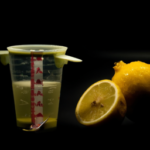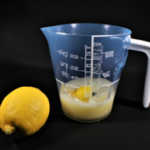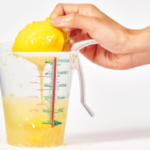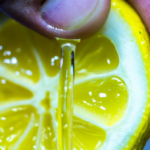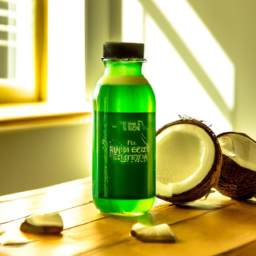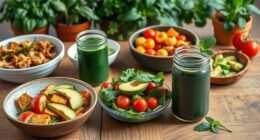As a home cook, I understand the importance of precise measurements in cooking. Even a small variation in the amount of an ingredient can have a big impact on the taste and texture of a dish. Lemon juice is a perfect example of an ingredient that requires careful measuring.
Whether you are making a salad dressing, marinade, or dessert, knowing how much juice is in half a lemon can make all the difference in the final product. Factors such as the size and ripeness of the lemon can affect the amount of juice that can be extracted from it. Additionally, the method used to extract the juice can also impact the amount of juice obtained.
In this article, we will explore the factors that affect the amount of juice in a lemon, the tools needed to juice a lemon, and the steps for juicing a lemon. We will also answer the question, how much juice is in half a lemon, and provide tips for getting the most juice out of your lemon.
So, let’s dive in and explore the world of lemon juice!
Key Takeaways
- The amount of juice obtained from half a lemon can vary based on factors such as ripeness and lemon size.
- Alternative juicing methods, such as using a juicer or piercing the ends of the lemon, can extract more juice than squeezing by hand.
- Fresh lemon juice is preferred over bottled juice for better flavor and more nutrients.
- Unused lemon juice should be stored in an airtight container in the refrigerator or frozen for up to 4-6 months to preserve flavor and freshness.
Understanding the Importance of Precise Measurements in Cooking
Cooking is all about precision, so it’s crucial to know exactly how much juice you can get from half a lemon. The importance of precision in cooking cannot be overstated. Accurate measurements can be the difference between a delicious meal and a culinary disaster.
The benefits of accurate measurements go beyond simply ensuring a dish tastes great. Precise measurements can also help you save time and money, reduce waste, and make meal planning and grocery shopping easier.
When it comes to juicing a lemon, the amount of juice you can get from half a lemon can vary depending on several factors. These factors include the size and ripeness of the lemon, the temperature of the lemon, and the juicing method used.
Understanding these factors can help you get the most juice out of your lemons and ensure that your recipes turn out perfectly.
Factors That Affect the Amount of Juice in a Lemon
When juicing a lemon, there are several factors that can affect the amount of juice you get. First, the ripeness of the fruit plays a major role. A fully ripe lemon will yield more juice than an underripe one.
Additionally, the size of the lemon and the juicing method used can also impact the amount of juice obtained. It’s important to consider these factors when measuring the juice of a lemon for cooking or baking.
Ripeness of the Fruit
Ripe lemons release a richer juice when halved. This is because they have reached their maximum level of acidity, which means they have produced the most juice possible. Here are four factors that determine the ripeness of a lemon:
-
Color: Ripe lemons have a bright, vibrant yellow color. If a lemon is still green, it’s not yet fully ripe.
-
Texture: Ripe lemons have a smooth, firm texture. If a lemon feels soft or mushy, it may be overripe.
-
Smell: Ripe lemons have a strong, citrusy smell. If a lemon has no smell or smells bad, it may be underripe or spoiled.
-
Taste: Ripe lemons have a tart, acidic taste. If a lemon tastes bland or sweet, it may not be ripe enough.
The ripeness of a lemon greatly affects the amount of juice it produces when halved. However, another factor that affects the amount of juice in a lemon is its size.
Size of the Lemon
The larger the lemon, the more it’s able to offer in terms of zesty flavor. Lemon size variability can make measuring the juice of half a lemon a bit tricky. It’s important to use consistent best practices when measuring lemon juice, especially when it comes to recipes that require precise measurements.
To measure the juice of half a lemon, begin by selecting a lemon that is of average size. Cut it in half crosswise, and squeeze the juice into a measuring cup. Use a strainer to catch any seeds or pulp that may have escaped. If the lemon is on the smaller side, you may need to use the juice from an entire lemon to get the desired amount. On the other hand, if the lemon is particularly large, you may get more than the required amount of juice, so be sure to measure carefully.
When it comes to juicing methods, there are several options available.
Juicing Method
To get the most out of your lemons, I recommend using an alternative juicing method such as a handheld juicer or reamer. These tools are easy to use and give you maximum juice extraction, ensuring that you get the most out of your lemons. By using these tools, you can be sure that you’re getting all the juice out of your lemon, which is important if you’re using it for cooking or making drinks.
One of the benefits of using freshly squeezed lemon juice is that it has a better flavor than the bottled juice. When you use fresh lemons, you get a bright, zesty flavor that can’t be replicated with bottled juice. Additionally, fresh lemon juice has more nutrients and antioxidants than bottled juice, making it a healthier choice.
By using a handheld juicer or reamer, you can easily extract the maximum amount of juice from your lemons, giving you all the benefits of fresh lemon juice.
To juice a lemon, you’ll need some tools.
Tools You Need to Juice a Lemon
You’re gonna need a juicer or a citrus reamer if you wanna get the most juice out of your lemon half. Choosing the right juicer can be important to get the best results. There are two main types of juicers: manual and electric. Manual juicers are typically cheaper and take up less space, but require more effort and may not extract as much juice. Electric juicers are more expensive, but are easier to use and can extract more juice. It’s important to choose a juicer that is appropriate for your needs and budget.
Tips for cleaning your juicing tools: After juicing your lemon half, it’s important to clean your juicer or citrus reamer properly to prevent bacteria growth and ensure that it’s ready for the next use. Follow these simple tips to clean your juicing tools: 1) Rinse immediately after use with warm water to remove any pulp or seeds. 2) Wash with soap and warm water. 3) Use a brush to clean any hard-to-reach areas. 4) Rinse thoroughly and dry before storing. By following these tips, you can ensure that your juicer or citrus reamer is clean and ready to use for your next juicing session.
When it comes to juicing a lemon, there are a few steps that you need to follow to get the best results. First, you’ll need to cut your lemon in half. Then, using your chosen juicing tool, extract as much juice as possible. Keep in mind that the amount of juice you get may vary depending on the size and ripeness of your lemon. In the next section, we’ll explore the different methods you can use to extract juice from your lemon half.
Steps for Juicing a Lemon
Before juicing a lemon, there are a few important steps to prepare the fruit properly. First, wash and dry the lemon to remove any dirt or residue.
Next, roll the lemon on a hard surface to help loosen the juice inside. When it comes to choosing a juicing method, consider whether you want to use a manual juicer, a citrus press, or simply squeeze the lemon by hand.
Extracting the juice can be done using a variety of techniques, from using a spoon to scraping out the flesh, to using a citrus reamer to extract every last drop.
Preparing the Lemon
After cutting the lemon in half, I typically start the juicing process by preparing the lemon.
First and foremost, I wash the lemon thoroughly to ensure that there’s no dirt or debris on the surface. This cleaning process is essential to prevent any harmful bacteria from contaminating the juice.
Once the lemon is clean, I dry it off and then cut it in half using a sharp knife. It’s important to use proper cutting techniques to ensure that the lemon halves are symmetrical, which’ll make juicing easier later on.
After the lemon is cut in half, I place it on a juicing tool, such as a citrus press or a reamer. Then, I apply pressure to the lemon and twist it around to extract the juice. Alternatively, I can also use a fork or my hands to squeeze the lemon halves to release the juice.
By choosing the juicing method that works best for me, I can efficiently extract all the juice from the lemon and accurately measure how much juice is in half a lemon.
Choosing the Juicing Method
After preparing the lemon, the next step is choosing the juicing method. There are two common methods for juicing lemons: handheld and electric juicers. Each method has its pros and cons.
Handheld juicers are simple, affordable, and require minimal cleanup. They work by manually pressing the lemon onto a cone-shaped reamer, which extracts the juice. However, handheld juicers may not be efficient for large quantities of lemons, and they can be tiring on the hands.
On the other hand, electric juicers can quickly juice large amounts of lemons with less effort. They come in various sizes and types, such as centrifugal, masticating, and citrus-specific juicers. However, they can be expensive, take up counter space, and require more cleanup.
When considering which juicing method to use, it is essential to weigh the pros and cons of each. For small batches, a handheld juicer may suffice, but for larger batches, an electric juicer may be more efficient. Ultimately, the chosen method will depend on personal preference, budget, and the amount of juice needed.
Now, onto the next step: extracting the juice.
Extracting the Juice
To extract the most amount of flavor from your lemon, you’ll want to roll it on a hard surface before cutting and squeezing it. This helps to break down the internal membranes and release the juice more easily.
Once you’ve rolled the lemon, cut it in half and use a juicer or your hands to extract the juice. There are alternative methods to extracting juice from a lemon, such as using a fork to poke holes in the lemon and squeezing the juice out. However, using a juicer or your hands will yield the most juice and provide the most benefits of using fresh lemons.
Fresh lemon juice is a good source of vitamin C and antioxidants, and it can add flavor to a variety of dishes. Now that we know how to extract the juice, let’s explore how much juice is in half a lemon.
How Much Juice Is in Half a Lemon?
You can easily extract about 1-2 tablespoons of juice from half a lemon, which is roughly equivalent to the amount of liquid in a shot glass.
Lemon juice is a great source of vitamin C and has numerous health benefits, such as aiding digestion and promoting hydration.
In recipes, lemon juice can also be used as a substitute for vinegar or other citrus juices.
To get the most juice out of your lemon, start by rolling it on a hard surface, such as a cutting board, to break down the inner membranes. Then, cut the lemon in half and use a juicer or your hands to squeeze out the juice.
For even more juice, try microwaving the lemon for a few seconds or placing it in hot water before juicing.
By using these tips, you can make the most out of your lemon and enjoy its refreshing flavor in your favorite recipes.
Tips for Getting the Most Juice Out of Your Lemon
As we’ve learned earlier, the amount of juice in a half of a lemon can vary depending on its size and ripeness. However, there are ways to ensure you get the most juice possible out of your lemon.
Here are some tips to help maximize your lemon’s juice yield. Firstly, roll the lemon on a hard surface before juicing. This can help break down the membranes inside the fruit and release more juice. Additionally, microwave the lemon for a few seconds to soften it and make it easier to juice. Finally, use an alternative juicing technique, such as piercing the ends of the lemon and squeezing it through a fork, to help extract more juice.
By using these methods, you can ensure that you are getting the most out of your lemon and not wasting any precious juice. Plus, using fresh lemon juice in drinks has numerous health benefits, such as aiding digestion and boosting your immune system.
Now that we know how to maximize our lemon juice yield, let’s think about how to store any unused juice. It’s important to note that lemon juice can quickly lose its flavor and nutritional benefits when exposed to air and light. Therefore, it’s best to store any unused lemon juice in an airtight container in the refrigerator. This will keep it fresh for up to a week and ensure that you can continue to enjoy the benefits of fresh lemon juice in your drinks.
Storing Lemon Juice
When it comes to storing lemon juice, I prefer to refrigerate it in an airtight container. This helps to preserve the freshness and flavor of the juice for up to a week.
Alternatively, you can also freeze lemon juice in ice cube trays and then transfer the cubes to a freezer-safe bag for longer storage.
Refrigeration
Refrigerating your freshly squeezed lemon juice can help preserve its flavor and extend its shelf life. While there are some benefits to keeping lemon juice at room temperature, such as ease of use for cooking and baking purposes, refrigeration is the best way to ensure that the juice stays fresh for longer periods of time.
When lemon juice is refrigerated, it slows down the growth of bacteria and mold, which can cause the juice to spoil quickly. In addition to its use in cooking and baking, lemon juice is also a popular ingredient in skin care products due to its high vitamin C content and antioxidant properties. However, using lemon juice that has been sitting at room temperature for too long can potentially cause skin irritation or even damage.
By refrigerating your lemon juice, you can ensure that it stays fresh and effective for all of your skin care needs. As we move on to the next section about freezing lemon juice, it’s important to note that refrigeration is still the best option for those who want to preserve the flavor and quality of their freshly squeezed juice.
Freezing
To keep the flavor of your lemon juice fresh for longer, you can freeze it. Not only does this preserve the taste, but it also makes for a refreshing ice cube that will add a zesty kick to your drinks like a burst of sunshine on a cloudy day. When frozen, lemon juice can last for up to 4-6 months in the freezer, making it a great ingredient to have on hand for a variety of recipes.
There are many benefits to using frozen lemon juice. Firstly, it’s a great way to add a burst of flavor to your drinks without diluting them with water. Simply drop a frozen lemon juice cube into your water or cocktail, and enjoy a burst of flavor. Secondly, frozen lemon juice is a great ingredient to use when making sorbets, granitas, or other frozen desserts. Lastly, it’s a great way to reduce food waste, as you can freeze any leftover lemon juice instead of letting it go to waste. Get creative with your frozen lemon juice and try using it in new and exciting ways!
When it comes to cooking, using lemon juice can be a great way to add a bright, acidic flavor to your dishes. From marinades to dressings, lemon juice is a versatile ingredient that can be used in many different ways.
Using Lemon Juice in Cooking
Adding a splash of fresh lemon juice to a dish can really enhance its flavor and add a bright, acidic element to balance out richer flavors. But did you know that lemon juice can also have benefits beyond the kitchen?
Here are a few ways that lemon juice can be used in skincare and cleaning:
-
Benefits of using lemon juice in skincare: Lemon juice contains vitamin C, which can help brighten and even out skin tone. It also has antibacterial properties that can help reduce acne and other blemishes. However, lemon juice can be harsh on the skin, so it should be diluted with water before use.
-
Lemon juice as a natural cleaning agent: Lemon juice can be used to clean and deodorize surfaces in the home. It can be mixed with baking soda to create a paste for cleaning sinks and tubs, or used to remove stains from fabrics. Lemon juice can also be used to freshen up the garbage disposal by pouring a mixture of lemon juice and ice down the drain.
While lemon juice is a versatile ingredient in the kitchen, it can also have practical uses outside of cooking. In the next section, we’ll explore some other ways that lemon juice can be used around the house.
Other Uses for Lemon Juice
Did you know that lemon juice can be used as a natural alternative to bleach for whitening clothes? According to a study, adding lemon juice to the rinse cycle can help remove stains and brighten colors. Lemon juice is a powerful cleaning agent that can also be used to clean household items such as cutting boards, coffee makers, and microwaves. With its acidic properties, it can effectively remove tough stains and grime without the use of harsh chemicals.
Lemon juice benefits extend beyond cleaning. It is also a great ingredient for homemade lemon juice cleaners. These all-natural cleaners are not only cost-effective but also eco-friendly. With just a few simple ingredients such as lemon juice, baking soda, and vinegar, you can create cleaning solutions that are safe for your family and the environment. The versatility of lemon juice makes it a must-have in any household for its cleaning and health benefits.
Frequently Asked Questions
How long can you store a half-cut lemon before it goes bad?
To maximize the shelf life of a half-cut lemon, use storing techniques like covering it with plastic wrap or placing it in an airtight container in the fridge. Lemon juice benefits include being a good source of vitamin C and aiding digestion.
Can you substitute bottled lemon juice for fresh lemon juice in recipes?
Comparing bottled lemon juice and fresh lemon juice is like comparing a painting to a photograph. Both have their pros and cons. Lemon juice substitutes like vinegar or lime juice can also work well in recipes.
How much lemon zest can be obtained from half a lemon?
When using half a lemon for zest, I typically obtain about 1-2 teaspoons. Lemon zest quantity can vary depending on the size and ripeness of the lemon, but it adds a bright and citrusy flavor to dishes.
Can you use a lime instead of a lemon for a recipe?
Using limes instead of lemons for a recipe has its pros and cons. Limes have a distinct flavor and are a good source of vitamin C. To keep them fresh, store them in a cool, dry place for up to a week.
How do you know when a lemon is ripe and ready to be juiced?
When determining if a lemon is ripe, visual cues such as color and firmness can help. Squeezing techniques can also reveal ripeness. Different types of lemons may have varying indicators of ripeness.
Conclusion
In conclusion, precise measurements are crucial in cooking, and understanding the amount of juice in half a lemon is no exception. By using the right tools and following the proper steps, you can extract the maximum amount of juice from a lemon. It’s important to keep in mind that factors such as the temperature of the lemon and the ripeness can affect the amount of juice you get.
To get the most out of your lemon, make sure to store it properly and use it in a timely manner. Lemon juice can be used in a variety of dishes, from marinades to desserts, and even as a natural cleaner. With these tips and techniques, you’ll be able to confidently incorporate fresh lemon juice into your cooking and enjoy the delicious, tangy flavor it adds to your dishes.
Ilana has been a vegan for over 10 years. She originally made the switch for health reasons, but soon found herself becoming more and more passionate about the ethical and environmental implications of a vegan lifestyle. Ilana is the author of The Graceful Kitchen, a blog all about veganism. She loves to cook up delicious and nutritious vegan meals, and share her recipes with others who are interested in leading a cruelty-free life. Ilana is also a strong advocate for using whole foods as the foundation of a healthy diet, and believes that going vegan is one of the best ways to achieve this.



